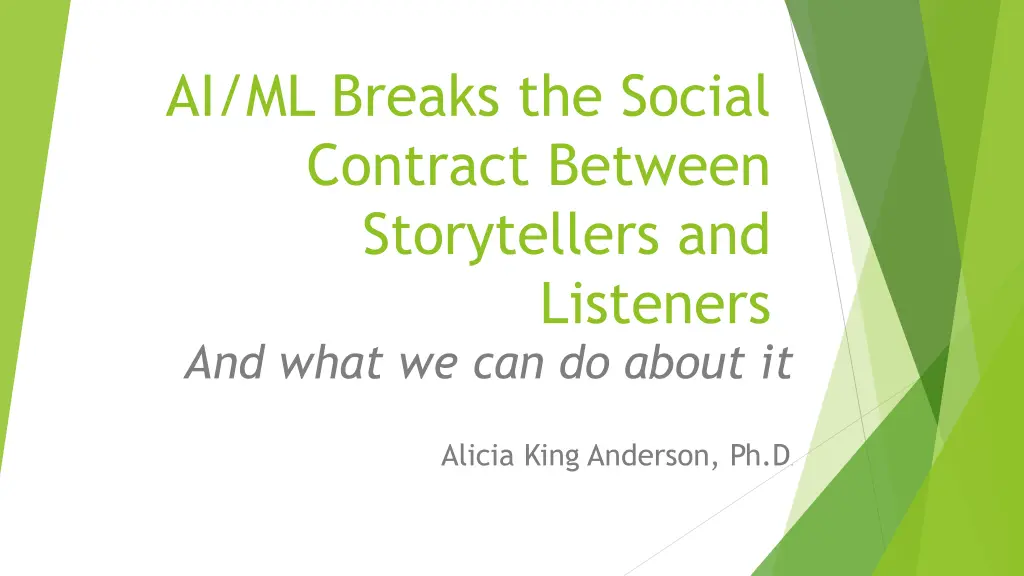
AI and ML Impact on Storytelling: Breaking the Social Contract
Discover how AI and ML technologies are disrupting the traditional social contract between storytellers and listeners. Dr. Alicia King Anderson delves into the essence of storytelling, the role of AI algorithms, and what actions can be taken to preserve the art of storytelling in a digital age.
Download Presentation

Please find below an Image/Link to download the presentation.
The content on the website is provided AS IS for your information and personal use only. It may not be sold, licensed, or shared on other websites without obtaining consent from the author. If you encounter any issues during the download, it is possible that the publisher has removed the file from their server.
You are allowed to download the files provided on this website for personal or commercial use, subject to the condition that they are used lawfully. All files are the property of their respective owners.
The content on the website is provided AS IS for your information and personal use only. It may not be sold, licensed, or shared on other websites without obtaining consent from the author.
E N D
Presentation Transcript
AI/ML Breaks the Social Contract Between Storytellers and Listeners And what we can do about it Alicia King Anderson, Ph.D.
About Alicia King Anderson Alicia King Anderson has a Ph.D. in Mythological Studies and Depth Psychology. She is a mythologist, storyteller, and instructor based in New Mexico. Her dissertation on The Storyteller Archetype stressed the importance of this topic. After nearly twenty years as an expert in organic search and digital marketing, Alicia is leveraging her technical experience with her analysis of ML and AI platforms She has scholarly chapters coming in two volumes by Vernon Press in 2025. She is currently editing a collection of essays called Advanced Unicorn Theory which will be published by McFarland Press in Spring 2025.
In this Presentation The Two Rules of Storytelling Knowing the Story & LLMs The consequences What we can do about it Pairing the Story & Algorithms The consequences What we can do about it How Folklorists Can Address This
The social contract with storytellers The gift for writing, the gift for story, whatever particular form it takes, is, I think, a gift for perceiving shape in the midst of the accident and muddle. Or since to say it s a gift is to make claim let me say it s an obsessive need to discover the shape, some shape, in the dishevelment of the actual. The writer, the storyteller, is haunted, I think by two things: by an immense awareness of the incoherence of life, and an awareness equally acute of life s coherence. It is all over the place and it is all so shapely. (Saxby 29-30) Though many storytelling rules are culture-specific, there are two rules that span across most storytelling traditions and practices: - Know the truth of the story - Pair the right story with the right audience at the right time When those two rules are followed, storytelling is a healing act. The mind is a meaning-making organ, and stories are our tools to make sense of the chaos of day-to-day sensory experience. Stories tell psychological and emotional truths, even when they seem fanciful.
Rule 1: You Have to Know the Story Some cultures require stories to be inherited, purchased, owned, or otherwise passed among tellers. However, when asked who has a right to tell a story, almost all tellers will state that it is the person who knows the story Storytelling flows from a deep desire to share, the desire to be open about something that has touched one deeply. The choice of story and the manner in which it is told reveal one s inner self. Although the storyteller may be recreating a traditional tale, it is his or her experience of life that enters the telling and makes the story ring true. (Baker 27, emphasis mine) Knowing the emotional truth that a story is telling usually through lived personal experience of the teller is the key to selecting which story to tell, and who can tell which stories.
Rule 2: Pairing Story with Audience On a sixth sense for the gift for selection of stories for a given occasion, Ruth Sawyer writes: Not every story will resonate with everyone Here is an indefinable something that acts as does the nose for the winetaster, as fingertips for the textile expert, as absolute pitch for the musician. I think one may be born with this; but it far more likely to become ingrained after years of [storytelling] experience. There are different stories that ought to be told at Wakes than Weddings The intuitive skill of reading the room, audience, and occasion is what Ruth Sawyer says is the key element of inborn talent for a storyteller. (The rest can be taught.) Sawyer, The Way of the Storyteller, p 26-27
Other rules and roles of note Other rules of storytelling across various cultures often dictate what time of year or time of day storytelling may take place. (e.g. the premise 1,001 Arabian Nights would fail if there were no cultural taboo against telling folktales during the day) Personal stories and self-aggrandizement is allowable, often it is required to also be comedic or obvious hyperbole - Glassie s work in Ballymenone covers this extensively Certain kinds of stories may be limited to specific social classes, occasions, or audiences (e.g. only for adults, only for children, etc. Fallassi s report of the Tuscan veglia covers this as an example)
A Large Language Model like ChatGPT or Google Bard is a giant autocorrect. It does not have comprehension of the things it generates, it only creates patterns it found in its source material. What context it is able to discern is based upon the context provided in that source material. What an LLM is and is not It is coded to sound correct. It does not perform searches. It does not know what it is saying.
When it comes to generating a story, an LLM doesn t know what it is saying, let alone the emotional truth of the story. A machine can never know emotional truth The lack of unconscious and intuitive artistry creates an uncanny valley feeling in the fiction it produces. Though it can mimic motifs, forms, and ideas of stories, can mimic and assume a storyteller s voice if fed that material, it can never generate a story that is emotionally true. (We have to make that leap for it.)
Consequences of this A story that doesn t speak to the unconscious falls flat. It may create a sensation of the uncanny valley. At the very least it feels hackneyed and trite. By giving over the creative capacity to LLMs, we produce reproductions that sound right but don t feel right. The stories told by an LLM may approximate meaning-making, or imitate it, but they cannot achieve it. LLMs are often plagiarizing original work of artists without permission, compensation, or fair use.
Algorithms and pairing the story to the audience
Algorithms like the For You feed on TikTok feed the social media world with content to discover new creators and hear from the people we follow. How algorithms work They are entirely built on for-profit companies predetermined success metrics. Many algorithms are honed for engagement, time on site, return users, active users, ad visibility, ad engagement, and so on. The algo may feel like it is useful to you or reflective of your tastes, but that is because you are doing what the company wants you to do.
How we feel with algos as storytellers The algorithm will often promote incendiary or enraging engagement bait style of content because Outrage = Stickiness. It may sprinkle in happy or wholesome stories, or validating stories, because these are random intermittent positive reinforcement, and humans will return to the feed more often with those nuggets. We may temporarily feel seen or validated, but this is often artificial, and frequently whisked away from us in the midst of the internet s response to a viral story. We do not see ourselves reflected back in a healing, kind, or gentle way. We certainly do not see our selves if our feelings and experiences are somewhere in the middle between peak moments like proposals and the abyss of despair or outrage. This results in many of us feeling lonely, sad, or inadequate.
Consequences of this: Depression, loneliness, and disconnection (Hunt et al, 2018) Meaninglessness of experience (Harte, 2022) Pessimism about the world and our ability to impact it (Grant 2009, Gurakan 2019) Dissociation and increased dissatisfaction (Baughan, 2022)
So what can we do about it? What folklorists can do about this
Encourage information literacy The more critically consumers can assess and understand the ways AI and ML are impacting what they see online, the better able they are to see through its flaws. Library Science Pathfinders such as LOC s Tracer Bullets and Metabibliographies If we understand the algorithms, we can game them. Blocking or muting the things we do not want to see more of or refusing to engage with them. Spending time on and engaging with the things we do care about. Cal State s A Beginner s Guide to Information Literacy Follow the money Offering vocabulary and metaphors to describe what s going on, and how its impacting everyone is a powerful tool
Put Pressure on Companies Algorithms can be improved by improving the success metrics. What if the Instagram algo used the Spotify success metrics instead? What would that look like? This kind of pressure from the marketplace can help improve the metrics that companies like Meta and TikTok use. Ideate and create new ways to share stories that don t rely on these mega corporations. Podcasts are a great example of this. Are there apps? Discord servers? Decentralized storytelling will be our way forward.
Tell the stories people need to hear By sharing stories that people need to hear and demonstrating the difference between real, human stories and those that are produced by machines, we can help inspire and educate potential AI users By avoiding using AI/LLMs ourselves, we can help spread the word about its potential risks, as well as it s possible good use cases. By calling out the algo for what it is when we participate on social media, we can help educate others about how they work.
Further Reading Baker, Augusta, and Ellin Greene. Storytelling: Art and Technique. Bowker, 1987. Davis, Eric. Techgnosis: Myth, Magic, & Mysticism in the Age of Information. North Atlantic, 2015. D gh, Linda. Folktales and Society: Story-telling in a Hungarian peasant community. Indiana UP, 1989. Chiang, Ted. Why AI isn t Going to Make Art , The New Yorker. August, 2024. Falassi, Alexander. Folklore by the Fireside: Text and context of the Tuscan veglia. Texas UP, 1980. Glassie, Henry H. Passing the Time in Ballymenone: Culture and History of an Ulster Community. Indiana UP, 2007. Romanyshyn, Robert D. Victor Frankenstein, the monster and the shadows of technology. Routledge, 2019. Sawyer, Ruth. The Way of theStoryteller. Penguin, 1976. Saxby, H.M. ed. Through folklore to literature: Papers presented at the Australian National Section of IBBY Conference on Children s Literature, Sydney 1978. IBBY Australia Publications, 1979. Slater, Glen. Jung vs Borg: Finding the Deeply Human in a Posthuman Age. Winter, 2024.
Thank you https://aliciakinganderson.com

